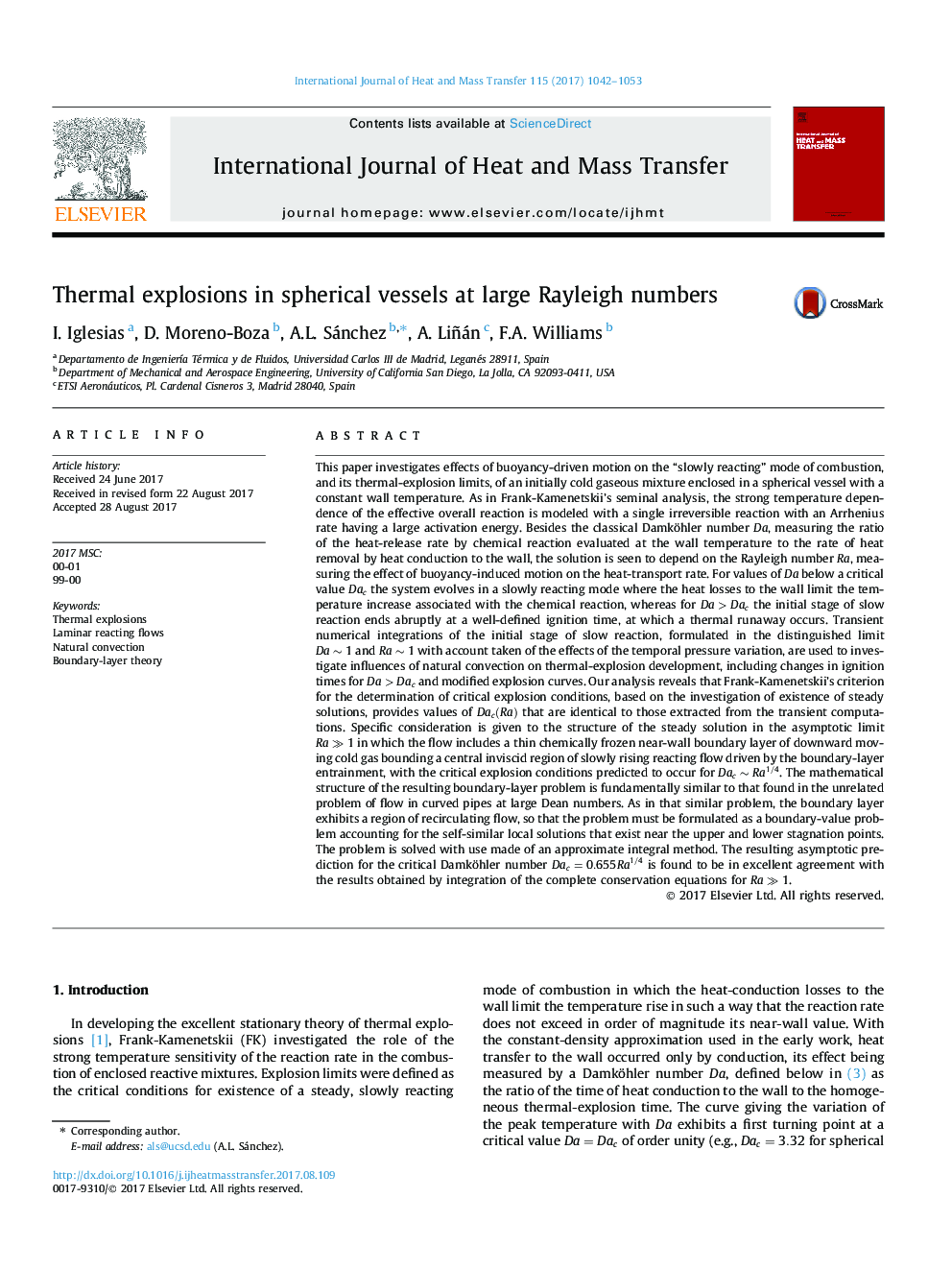| کد مقاله | کد نشریه | سال انتشار | مقاله انگلیسی | نسخه تمام متن |
|---|---|---|---|---|
| 4994031 | 1458025 | 2017 | 12 صفحه PDF | دانلود رایگان |
عنوان انگلیسی مقاله ISI
Thermal explosions in spherical vessels at large Rayleigh numbers
ترجمه فارسی عنوان
انفجارهای حرارتی در عروق کروی در تعداد رایلی بزرگ
دانلود مقاله + سفارش ترجمه
دانلود مقاله ISI انگلیسی
رایگان برای ایرانیان
کلمات کلیدی
انفجارهای حرارتی، جریان واکنش لامینار، پودر طبیعی نظریه لایه مرزی، 00-01، 99-00،
موضوعات مرتبط
مهندسی و علوم پایه
مهندسی شیمی
جریان سیال و فرایندهای انتقال
چکیده انگلیسی
This paper investigates effects of buoyancy-driven motion on the “slowly reacting” mode of combustion, and its thermal-explosion limits, of an initially cold gaseous mixture enclosed in a spherical vessel with a constant wall temperature. As in Frank-Kamenetskii's seminal analysis, the strong temperature dependence of the effective overall reaction is modeled with a single irreversible reaction with an Arrhenius rate having a large activation energy. Besides the classical Damköhler number Da, measuring the ratio of the heat-release rate by chemical reaction evaluated at the wall temperature to the rate of heat removal by heat conduction to the wall, the solution is seen to depend on the Rayleigh number Ra, measuring the effect of buoyancy-induced motion on the heat-transport rate. For values of Da below a critical value Dac the system evolves in a slowly reacting mode where the heat losses to the wall limit the temperature increase associated with the chemical reaction, whereas for Da>Dac the initial stage of slow reaction ends abruptly at a well-defined ignition time, at which a thermal runaway occurs. Transient numerical integrations of the initial stage of slow reaction, formulated in the distinguished limit Daâ¼1 and Raâ¼1 with account taken of the effects of the temporal pressure variation, are used to investigate influences of natural convection on thermal-explosion development, including changes in ignition times for Da>Dac and modified explosion curves. Our analysis reveals that Frank-Kamenetskii's criterion for the determination of critical explosion conditions, based on the investigation of existence of steady solutions, provides values of Dac(Ra) that are identical to those extracted from the transient computations. Specific consideration is given to the structure of the steady solution in the asymptotic limit Raâ«1 in which the flow includes a thin chemically frozen near-wall boundary layer of downward moving cold gas bounding a central inviscid region of slowly rising reacting flow driven by the boundary-layer entrainment, with the critical explosion conditions predicted to occur for Dacâ¼Ra1/4. The mathematical structure of the resulting boundary-layer problem is fundamentally similar to that found in the unrelated problem of flow in curved pipes at large Dean numbers. As in that similar problem, the boundary layer exhibits a region of recirculating flow, so that the problem must be formulated as a boundary-value problem accounting for the self-similar local solutions that exist near the upper and lower stagnation points. The problem is solved with use made of an approximate integral method. The resulting asymptotic prediction for the critical Damköhler number Dac=0.655Ra1/4 is found to be in excellent agreement with the results obtained by integration of the complete conservation equations for Raâ«1.
ناشر
Database: Elsevier - ScienceDirect (ساینس دایرکت)
Journal: International Journal of Heat and Mass Transfer - Volume 115, Part B, December 2017, Pages 1042-1053
Journal: International Journal of Heat and Mass Transfer - Volume 115, Part B, December 2017, Pages 1042-1053
نویسندگان
I. Iglesias, D. Moreno-Boza, A.L. Sánchez, A. Liñán, F.A. Williams,
